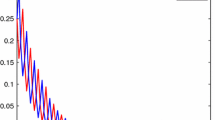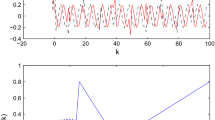Abstract
This paper aims to analyze the stability of Cohen–Grossberg neural networks with saturated impulse inputs. By using the method of Lyapunov functions, convex analysis and matrix inequality, some sufficient conditions are obtained to ensure the stability of the Cohen–Grossberg networks with saturated impulse inputs, including full state constraints and partial state constraints. And some conservative corollaries are obtained. In addition, the fixed time-delay network with fixed impulsive inputs is analyzed by the similar method. Meanwhile, the effectiveness and validity are verified by some numerical examples.






Similar content being viewed by others

References
Li H, Li C, Huang T, Zhang W (2018) Fixed-time stabilization of impulsive Cohen–Grossberg BAM neural networks. Neural Netw 98:203–211
Cohen M, Grossberg S (1983) Absolute stability of global pattern formation and parallel memory storage by competitive neural networks. IEEE Trans Syst Man Cybern 13(5):815–826
Liao X, Li C (2006) Global attractivity of Cohen–Grossberg model with finite and infinite delays. J Math Anal Appl 315(1):244–262
Halanay A (1966) Differential equations:stability, oscillations, time lags. Academic Press, New York
Peng D, Li X, Aouiti C, Miaadi F (2018) Finite-time synchronization for Cohen–Grossberg neural networks with mixed time-delays. Neurocomputing 294:39–47
Wang D, Huang L (2018) Robust synchronization of discontinuous Cohen–Grossberg neural networks: pinning control approach. J Frankl Inst 355(13):5866–5892
Rajivganthi C, Rihan F, Lakshmanan S, Muthukumar P (2016) Finite-time stability analysis for fractional-order Cohen–Grossberg BAM neural networks with time delays. Neural Comput Appl 28(2):1–12
Wang D, Huang L, Tang L, Zhuang J (2018) Generalized pinning synchronization of delayed Cohen–Grossberg neural networks with discontinuous activations. Neural Netw 104:80–92
Zhou Y, Li C, Chen L, Huang T (2017) Global exponential stability of memristive Cohen–Grossberg neural networks with mixed delays and impulse time window. Neurocomputing 275:2384–2391
Zhou Y, Li C, Huang T, Wang X (2017) Impulsive stabilization and synchronization of Hopfield-type neural networks with impulse time window. Neural Comput Appl 28(4):775–782
Li Y (2016) Impulsive synchronization of stochastic neural networks via controlling partial states. Neural Process Lett 46(1):59–69
Liao X, Li C, Wong K (2004) Criteria for exponential stability of Cohen–Grossberg neural networks. Neural Netw 17(10):1401–1414
Yang X, Song Q, Cao J, Lu J (2018) Synchronization of coupled markovian reaction–diffusion neural networks with proportional delays via quantized control. IEEE Trans Neural Netw Learn Syst 2018:1–8
Yang X, Lu J, Ho DWC, Song Q (2018) Synchronization of uncertain hybrid switching and impulsive complex networks. Appl Math Model 59:379–392
Li Y, Li B, Liu Y (2018) Set stability and stabilization of switched Boolean networks with state-based switching. IEEE Access 6:35624–35630
Desoer C, Vidyasagar M (1975) Feedback systems: input–output properties. Academic Press, New York
Sayli M, Yilmaz E (2016) State-dependent impulsive Cohen–Grossberg neural networks with time-varying delays. Neurocomputing 171:1375–1386
Zhang X, Li C, Huang T (2017) Impacts of state-dependent impulses on the stability of switching Cohen–Grossberg neural networks. Adv Differ Equ 1:316–336
Fu X, Li X (2009) Global exponential stability and global attractivity of impulsive Hopfield neural networks with time delays. J Comput Appl Math 231(1):187–199
Yang X, Li X (2018) Finite-time stability of linear non-autonomous systems with time-varying delays. Adv Differ Equ 1:101
Li X, Cao J, Perc M (2018) Switching laws design for stability of finite and infinite delayed switched systems with stable and unstable modes. IEEE Access 6:6677–6691
Yang X, Li X, Cao J (2018) Robust finite-time stability of singular nonlinear systems with interval time-varying delay. J Frank Inst 355(3):1241–1258
Li X, Zhang X, Song S (2017) Effect of delayed impulses on input-to-state stability of nonlinear systems. Automatica 76:378–382
Li P, Li X, Cao J (2018) Input-to-state stability of nonlinear switched systems via Lyapunov method involving indefinite derivative. Complexity 2018:1–8
Li X, Wu J (2017) Sufficient stability conditions of nonlinear differential systems under impulsive control with state-dependent delay. IEEE Trans Autom Control 63(1):306–311
Li X (2012) Further analysis on uniform stability of impulsive infinite delay differential equations. Appl Math Lett 25(2):133–137
Qiu B, Li L, Peng H, Yang Y (2018) Asymptotic and finite-time synchronization of memristor-based switching networks with multi-links and impulsive perturbation. Neural Comput Appl 2018:1–17
Zhang Z, Liu X, Lin C, Zhou S (2017) Exponential stability analysis for delayed complex-valued memristor-based recurrent neural networks. Neural Comput Appl 2:1–11
Li X, Wu J (2016) Stability of nonlinear differential systems with state-dependent delayed impulses. Automatica 64:63–69
Liu C, Liu X, Yang H, Zhang G, Cao Q (2018) New stability results for impulsive neural networks with time delays. Neural Comput Appl 10:1–12
Lakshmikantham V, Bainov D, Simeonov P (1989) Theory of impulsive differential equations. World Scientific, Singapore
Chen Y, Wang Z, Fei S, Han Q (2018) Regional stabilization for discrete time-delay systems with actuator saturations via a delay-dependent polytopic approach. IEEE Trans Autom Control 99:1–8
Min H, Xu S, Zhang B (2018) Output-feedback control for stochastic nonlinear systems subject to input saturation and time-varying delay. IEEE Trans Autom Control 64(1):359–364
Zhang X, Su C (2018) Stability analysis and antiwindup design of switched linear systems with actuator saturation. Int J Control Autom Syst 16(3):1247–1253
Zhang S , Yu C (2018) Controller design for flexible spacecraft attitude tracking with actuator saturation. In: 2018 10th International conference on measuring technology and mechatronics automation (ICMTMA). IEEE Computer Society (2018)
Liu Y, Tong S (2017) Barrier Lyapunov functions for Nussbaum gain adaptive control of full state constrained nonlinear systems. Automatica 76:143–152
Hu T, Lin Z (2001) Control systems with actuator saturation: analysis and design. Springer, New York
Li L, Li C, Li H (2018) An analysis and design for time-varying structures dynamical networks via state constraint impulsive control. Int J Control 2018:1–9
Si W, Qi L, Hou N (2019) Finite-time adaptive neural control for uncertain nonlinear time-delay systems with actuator delay and full-state constraints. Int J Syst Sci 2019:1–13
Qi W, Kao Y, Gao X (2018) Controller design for time-delay system with stochastic disturbance and actuator saturation via a new criterion. Appl Math Comput 320:535–546
Li L, Li C, Li H (2018) Fully state constraint impulsive control for non-autonomous delayed nonlinear dynamic systems. Nonlinear Anal: Hybrid Syst 29:383–394
Bouzerdoum A, Pattison T (1993) Neural network for quadratic optimization with bound constraints. IEEE Trans Neural Netw 4(2):293–304
Hu T, Lin Z, Chen B (2002) An analysis and design method for linear systems subject to actuator saturation and disturbance. Automatica 38(2):351–359
Johnson E, Calise AJ (2010) Neural network adaptive control of systems with input saturation. Am Control Conf 5:3527–3532
Liu Y, Tong S (2016) Barrier Lyapunov functions-based adaptive control for a class of nonlinear pure-feedback systems with full state constraints. Automatica 64:70–75
Acknowledgements
The authors express sincerest gratitude to the editors and anonymous reviewers for their constructive comments, which have played an significant role in improving this paper. This work was supported by the National Natural Science Foundation of China under Grants 61873213 and 61633011, and in part by the Chongqing Research Program of Basic Research and Frontier Technology of cstc2015jcyjBX0052.
Author information
Authors and Affiliations
Corresponding author
Additional information
Publisher's Note
Springer Nature remains neutral with regard to jurisdictional claims in published maps and institutional affiliations.
Rights and permissions
About this article
Cite this article
Xie, R., Li, C. Stability Analysis on Cohen–Grossberg Neural Networks with Saturated Impulse Inputs. Neural Process Lett 51, 1265–1283 (2020). https://doi.org/10.1007/s11063-019-10146-1
Published:
Issue Date:
DOI: https://doi.org/10.1007/s11063-019-10146-1



